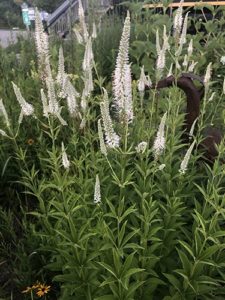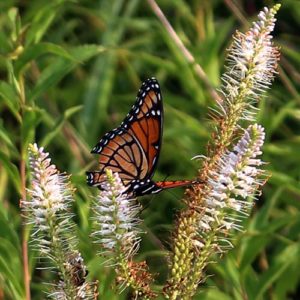General Biology and Life History of Culver’s Root

Culver’s root (Veronicastrum virginicum) is an herbaceous perennial that is native to most of the eastern U.S. and parts of eastern Canada. It is much more common in some states than others. Culver’s root grows naturally in moist to wet meadows or open woods. It can grow 3-6 feet tall and 2-4 feet wide. However, much of the plant’s height is from its flower stalks.
The flower stalks are branched and produce long, dense spikes of white flowers. Each spike of flowers can be between 5 and 8 inches long. The flowers bloom in mid to late summer. (Typically, June to August in Kentucky.) The flowers at the bottom of the spike will bloom before the flowers at the top of the spike. Each plant will often produce flowers for several weeks to a month.
Culver’s root seeds are extremely tiny. The plant can reproduce both from seed and vegetatively through runners. However, the runners tend to stay clumped around the mother plant and don’t become very aggressive.
Pollinator and Wildlife Uses
Most mammalian herbivores, including deer, typically avoid eating Culver’s root. However, pollinators love the tall flower stalks that bloom for several weeks to a month during the middle of summer. Many different species of native bees, as well as, honey bees are drawn to the flowers to gather nectar and/or pollen. Butterflies, moths, flower flies, and several species of wasps will also visit the flowers.
Historical Uses of Culver’s Root by People
Culver’s root was used medicinally by several Native American tribes in the eastern U.S. It was also used by early pioneers. The common name of “Culver’s root” is generally thought to refer to an early physician who commonly used the root to treat his patients. Some modern herbalists are still interested in Culver’s root.

Incorporating Culver’s Root into Your Yard
In garden settings, Culver’s root is fairly adaptable when it comes to site characteristics. It prefers moister soils which makes it great for rain gardens or that wetter area on your property. However, it can grow in medium moisture soil if it is watered occasionally during drier periods. It can also take full sun to part shade, but will sometimes flop over if it is too shady of an area. Like with most full sun to part shade plants, I suggest erring on the side of more sun rather than more shade, if given the option.
Because Culver’s root can get so tall, it is best planted in the back of a linear garden bed or toward the center of a circular bed. That way it can serve as a focal or anchor point without blocking other plants. Its growth can start out a little on the slow side, but will quickly take off once it has become established. Plants can be divided like other perennial garden plants if the clumps become too large. You can often find it for sale in native plant nurseries.
Summary
Culver’s root grows naturally in wet meadows and open woods. Its long-lasting flower spikes are a magnet for many different species of bees seeking nectar and pollen during the middle of the summer. Culver’s root also makes a great addition to relatively sunny native plant gardens, pollinator gardens, and rain gardens. Another bonus is that it is deer resistant, which is often an important consideration in areas with high deer populations.

Backyard Ecology: Exploring Nature in Your Backyard
Nature isn’t just “out there.” It’s all around us, including right outside our doors. Hi, my name is Shannon Trimboli, and I am the host of Backyard Ecology. I live in southcentral Kentucky and am a wildlife biologist, educator, author, beekeeper, and owner of a nursery specializing in plants for pollinators and wildlife conservation. I invite you to join me as we ignite our curiosity and natural wonder, explore our yards and communities, and improve our local pollinator and wildlife habitat. Learn more or subscribe to my email list at www.backyardecology.net.

Leave a Reply